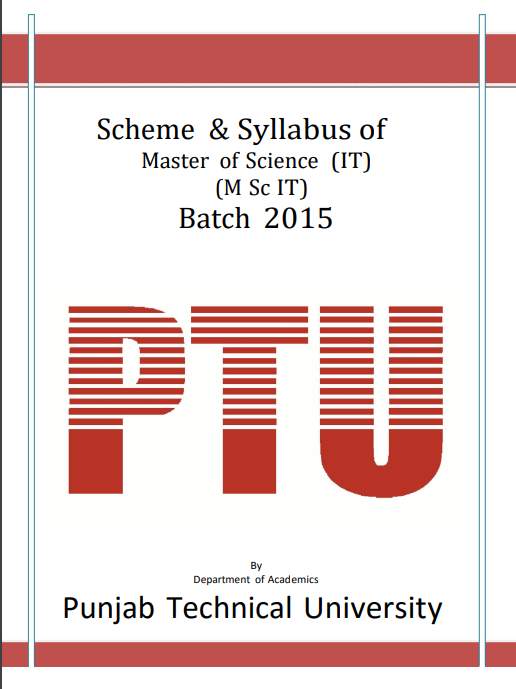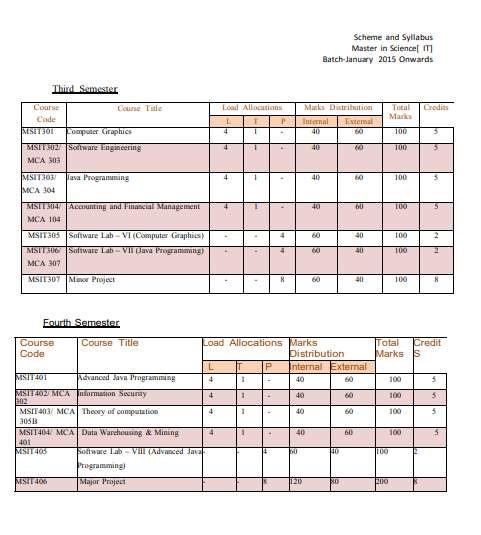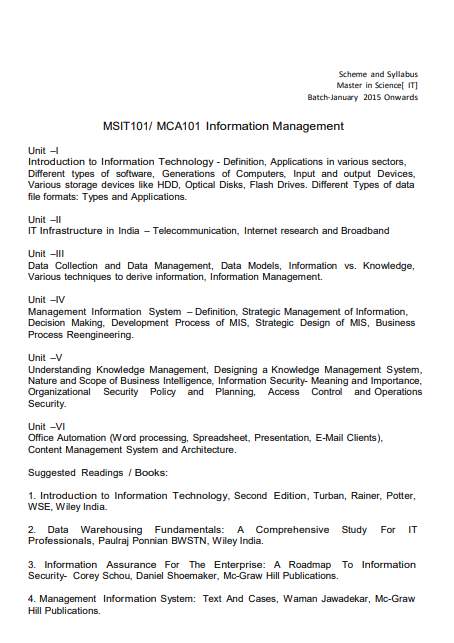As you want to get the syllabus of M.Sc Information Technology in Punjab Technical University so here is the information of the same for you:
Semester 1:
Computer Fundamentals
Programming in C
C++ & data structures
Web Tecnologies
Operating Systems
Communication & Soft Skills
Software Lab-I (C & C++)
Semester 2:
Computer Networks
RDBMS
Software Engineering & Project Management
Visual Basic Programming
Project (RDBMS &
VB) & Viva
Semester 3:
C# with .net
Operating System Administratin with Windows 2000
Advanced Web Development
WAP & WML
Java Programming
Software Lab-II (C# & Java)
Software Lab-III (Web Design & WML)
Semester 4:
Linux Administration
Database Administration
Management Information Systems
Advanced Java Programming
Project (Advanced Java) & Viva
Software Lab-IV (Network Administration)
COMPUTER FUNDATMENTALS:
Section 1:
Introduction:
Characteristics of Computers; The Evolution of Computers; The Computer Generations (First Generation(1942-1955), Second Generation (1955 – 1964), Third Generation (1964 – 1975), Fourth Generation (1975 – 1989), Fifth Generation (1989 – Present)).
Basic Computer Organization:
Input Unit; Output Unit; Storage Unit; Arithmetic Logic Unit; Control Unit; Central Processing Unit; The System Concept.
Number Systems:
Non-Positional Number Systems; Positional Number Systems (Binary Number System, Octal Number System, Hexadecimal Number System); Converting One number System to Another (Converting to Decimal from Another Base, Converting from Decimal to Another Base (Division-Remainder Technique), Converting from a Base Other Than 10 to a Base Other Than 10, Shortcut Method for Binary to Octal Conversion, Shortcut Method for Octal to Binary Conversion, Shortcut Method for Binary to Hexadecimal Conversion, Shortcut Method for Hexadecimal to Binary Conversion); Fractional Numbers.
Processor and Memory:
The Central Processing Unit (CPU) (The Control Unit, The Arithmetic Logic Unit (ALU), Instruction Set, Registers, Processor Speed, Types of Processors); The Main Memory (Storage Evaluation Criteria, Main Memory Organization, Main Memory Capacity, RAM, ROM, PROM and EPROM, Cache Memory.
Secondary Storage Devices:
Sequential and Direct-Access Devices; Magnetic Tape (Basic Principles of Operation, Types of Magnetic Tapes, Advantages and Limitations of Magnetic Tapes, Uses of Magnetic Disks); Optical Disk (Basic Principles of Operation, Types of Optical Disks, Advantages and Limitations of Optical Disks, Uses of Optical Disks); Mass Storage Devices (Disk Array, Automated Tape Library, CD-ROM Jukebox); Storage Hierarchy.
Input-Output Devices:
Input Devices (Keyboard Devices, Point-and-Draw Devices, Data Scanning Devices, Digitizer, Electronic Card Reader, Voice Recognition Devices, Vision-Input System); Output Devices (Monitors, Printers, Plotters, Screen Image Projector, Voice Response Systems).
Section 2:
Computer Languages:
Analogy with Natural Languages; Machine Language (Advantages and Limitations of Machine Language); Assembly Language (Assembler, Advantages of Assembly Language over Machine Language, Limitations of Assembly Language, Assembly Languages with Macro Instructions); High-Level Language (Compiler, Linker, Interpreter, Advantages and Limitations of High-Level Languages); Object-Oriented Programming Languages; Some High-Level Languages (FORTRAN, COBOL, BASIC, Pascal); Some More High-Level Languages (C and C++, Java, RPG, LISP, SNOBOL); Characteristics of a Good Programming Language; Selecting a Language for Coding an Application; Subprogram.
Application Software Packages:
Word-Processing Package (What it is?, Commonly Supported Features); Spreadsheet Package (What it is?, Commonly Supported Features); Graphics Package (What it is?, Commonly Supported Features); Personal Assistance Package (What it is?, Commonly Supported Features).
The Internet:
Definition (What it is?); Brief History; It’s Basic Services (Electronic Mail, File Transfer Protocol, Telnet. Usenet News, The World Wide Web); WWW Browsers; Uses of the Internet.
Classification of Computers:
Notebook Computers; Personal Computers (PCs); Workstations; Mainframe Systems; Supercomputers; Clients and Servers.
Section-III:
MICROSOFT OFFICE 2000:
Microsoft Office 2000:
Introduction; Microsoft Word 2000; Microsoft Excel 2000; Microsoft Access 2000; Microsoft Powerpoint 2000, Microsoft Outlook 2000; Internet Explorer 5.0; Microsoft FrontPage 2000; Microsoft Publisher 2000; Microsoft PhotoDraw 2000; Microsoft Office Bar; Using the Mouse (To Click, To double-click, To select, To drag, To scroll, To choose from a menu, To move a window, To resize a window, To minimize a window, To restore a minimized window, To maximize a window, To switch windows, To close a window, Remember); Microsoft Office 2000 and Web (Microsoft Word 2000, Microsoft Excel 2000, Microsoft Access 2000, Microsoft Powerpoint 2000, Microsoft Outlook 2000, Microsoft FrontPage 2000); Common Keyboard Commands.
Creating Your Document in Word 2000:
Introduction; Saving the file; Formatting the text, Alignment of Text; Applying Fonts; Spell Checking; Consulting Thesaurus; Assign Character Styles (Assign a Character Style, Create a character style); Borders and Shading (Apply Borders and Shading); Closing of the File; Save as option; Open File (From File menu, From Open Icon); Printing Your Document.
Proofing Your Document in Word 2000:
Introduction; Editing Tools; AutoCorrect (Add AutoCorrect Entries Without Formatting, Add New AutoCorrect Entries with Formatting); Auto Text (Creating an AutoText Entry, AutoComplete Option); AutoFormat (AutoFormat as You Type, AutoFormat on Command, AutoFormatting Text); Find and Replace; Find; Replace Text; Page Numbering; Header and Footer (Adding a Header or Footer in Your Document); Footnotes and Endnotes (Add a Footnote or Endnote).
Creating a Worksheet in Excel 2000:
Introduction; Copying Formula.
Advanced Techniques of Excel 2000:
Introduction; Auditing a Workbook (To Trace the Precedents for a Formula); Comment Inserting (To Insert a Comment); Formulas That Make Decisions (How the If function works); Headers and Footers; Merging Workbooks (To merge workbooks); Outlines (Outline a Worksheet Automatically, Clear Entire Outline, Show or Hide Outline Symbols, Group Rows or Columns in an Outline, Ungroup Rows or Columns in an Outline, Remove Group from Outline, Set Outline Options); Printing Column and Row Labels on Every Page; Protecting a Workbook (To unlock cells so that others can edit the cell contents, To protect a workbook, To share a workbook); Ranges, Naming (To name a range); References (Absolute references, Mixed references); Seeking Goals (To seek a goal); Sheets Naming (To Name a Sheet); Working with Workbooks (Copying Entries Between Workbooks, Moving Sheets Between Workbooks, Deleting Sheets).
Creating Presentation Using AutoContent Wizard, Creating New Presentation, Creating Presentation from Template, Changing views.
PROGRAMMING IN C:
Section 1:
Origin & Introduction to C:
About C, Evolution of C, Programming languages, Structure of a C program, Compiling a C program, Compiler & interpreters, Pseudocodes, Simple C program, Character set in C, Keywords in C, Hierarchy of operators, Basic data types, Qualifiers used with basic data types, Variables in C, Type declaration, Output function, Input function and format specifiers, arithmetic operators, Unary operators, Relational and logical operators, Constraints in C.
Decision Making, Branching & looping:
Why control statements, The if statement, if else statement, for statement, while loop, do while statements, break statements, continue statements, switch statement, goto statement, ternary operators.
Section 2:
Arrays & String Handling:
Introduction to arrays, advantages of arrays, types of arrays, array declaration, array initialization, accessing data from array, array inside the memory, multidimensional arrays, Character arrays, Array overflow, String Variables, Reading & writing strings, string handling functions.
User Defined Functions:
Introduction to functions, advantages of functions, declaring a function, calling a function, variables, passing arguments to a function, nested functions, passing array to functions, recursion in functions, Call by value and Call by reference.
Section 3:
Pointers:
Introduction to pointers, pointer variations, dynamic memory allocation, pointers and arrays, pointers to pointers, functions returning pointers, 2 dimensional arrays and pointers, array of pointers.
Structures & Unions:
Structure definition, Structure initialization, arrays of structures, arrays within structures, structures & functions, Unions.
File Management in C:
Defining & opening a file, closing a file, I/O operations on file, error handling during I/O operations, Random Access Files.
C++ & DATA STRUCTURES:
Section 1:
DATA TYPES, OPERATORS AND STATEMENTS:
Identifiers and Keywords, Constants (String constants, Numeric constants, Character constants), C++ Operators (Arithmetic operators, Assignment operators, Comparison and logical operators, Bitwise logical operator, Special operators), Type Conversion.
WRITING A PROGRAM IN C++:
Declaration of Variables, Statements, Simple C++ Programs, Features of iostream.h, Keyboard and screen I/O, Manipulator Functions, Predefined manipulators, Input and Output (I/O) Stream Flags.
CONTROL STATEMENTS:
Conditional Expressions (if statement, if - e1se statement), switch Statement, Loop Statements( for loop, while loop, do-while loop), Breaking Control Statements(break statement, continue statement, goto statement).
FUNCTIONS AND PROGRAM STRUCTURES:
Defining a Function, return Statement, Types of Functions, Actual and Formal Arguments, Local and Global Variables, Default Arguments, Multifunction Program, Storage Class Specifiers (Automatic variable, Register variable, Static variable, External variable), Recursive Function, Preprocessors ( Simple macro definitions, Macro with parameters, Other Processing Techniques, Conditional Compilation), Header Files, Standard Functions.
ARRAYS:
Array Notation, Array Declaration, Array Initialization, Processing with Array, Arrays and Functions, Multidimensional Arrays, Character Array.
POINTERS:
Pointer Declaration (Pointer operator, Address operator, Pointer expressions), Pointer Arithmetic, Pointers and Functions (Call by value, Call by reference, Pointers to functions, Passing a function to another function), Pointers and Arrays, Pointer and one dimensional array, Pointer and multidimensional array, Pointers and Strings, Array of Pointers, Pointers to Pointers.
Section 2:
CLASSES AND OBJECTS:
Structures and Classes, Declaration of Class, Member Functions, Defining the Object of a Class, Accessing a Member of Class, Array of Class Objects, Pointers and C]asses, Unions and Classes, Classes within Classes {Nested Class), Constructors (Copy constructors, Default constructors), Destructors, lnline Member Functions, Static Class Members (Static data member, Static member functions), Friend Functions, Dynamic Memory Allocations, this Pointer.
INHERITANCE:
Single Inheritance, Types of Base Classes (Direct base classes, Indirect base classes), Types of Derivation (Public inheritance, Private inheritance, Protected inheritance), Ambiguity in Single Inheritance, Array of Class Objects and Single Inheritance, Multiple Inheritance (Array of class objects and multiple inheritance, Ambiguity in the multiple inheritance), Container Classes, Member Access Control (Accessing the public data, Accessing the private data, Accessing the protected data, Accessing private member by friend class).
OVERLOADING:
Function Overloading (Function overloading with various data types, Function overloading with arguments, Scoping rules for function overloading, Special features of function 0verloading), Operator Overloading, Overloading assignment
For more detailed information I am uploading a PDF file which is free to download:
(Syllabus of M.Sc Information Technology in Punjab Technical University)
http://dde.ptu.ac.in/IT-Courses/MSC-...T-LE,PGDCA.pdf Contact Details:
I.K Gujral Punjab Technical University
Jalandhar-Kapurthala Highway,
Kapurthala
Near Pushpa Gujral Science City
Block N,
Saket
Jalandhar,
Punjab 144601
India
[MAP]I.K Gujral Punjab Technical University Saket Jalandhar Punjab[/MAP]



